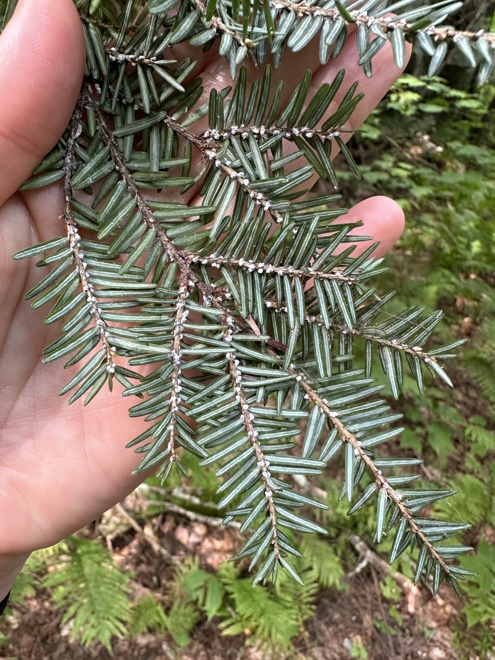
An infested hemlock branch showing the woolly masses of hemlock woolly adelgid, found at the LGLC’s protected Clark Hollow Bay Preserve in Putnam.
The Lake George Land Conservancy (LGLC) is pleased to announce that it has been awarded a grant of $86,215 to support the LGLC’s rapid response and management efforts to control the invasive hemlock woolly adelgid (HWA) on its Clark Hollow Bay Preserve in the Town of Putnam. The LGLC’s Land Steward discovered an infestation of HWA at its recently acquired 60-acre Clark Hollow Bay property in the spring of 2023. This was the first time HWA had been found on LGLC protected property, and is at the northern frontier of the HWA infestation at Lake George and in the Adirondack Park.
Hemlock trees play an important role in the forests where they grow, preventing soil erosion and providing habitat for both terrestrial and aquatic wildlife. Left alone, HWA will kill hemlocks within five to ten years, making early detection critical to effective management.
Hemlocks are a dominant tree species in much of the forest surrounding Lake George, making HWA especially dangerous for the preservation of water quality and health of the whole lake ecosystem.
This summer, LGLC staff identified 108 trees with known HWA infestations on the Clark Hollow Bay Preserve; the actual number of infested trees is estimated to be at least doubled, when taking into account those trees that were inaccessible for evaluation.

Dr. Mark Whitmore of the New York State Hemlock Initiative joined LGLC staff in 2023 to confirm the presence of hemlock woolly adelgid at the Clark Hollow Bay Preserve.
The LGLC’s HWA management plan for the Clark Hollow Bay Preserve includes the use of both biological controls for long-term management, and chemical controls in the short-term. In partnership with the New York State Hemlock Initiative (NYSHI), the LGLC released Laricobius nigrinus beetles on the property in fall of 2023. The beetle is native to the Pacific Northwest and preys exclusively upon HWA. Highly controlled chemical application was also conducted on the property with help from the Adirondack Park Invasive Plant Program (APIPP).
The grant will fund three years of additional monitoring and management activity at the Clark Hollow Bay Preserve.
LGLC Executive Director Mike Horn said, “With this funding we are able to combat hemlock woolly adelgid on this important protected property. We are grateful to the New York State Department of Environmental Conservation, as well as the resources and expertise provided by NYSHI and APIPP, for making this work possible.”
This grant is part of the New York State Department of Environmental Conservation’s Invasive Species Grant Program, which provides funding for aquatic and terrestrial invasive species spread prevention, early detection and rapid response, lake management planning, research, and education and outreach.
The Invasive Species Grant Program is supported by the State’s Environmental Protection Fund (EPF) and administered by the Bureau of Invasive Species and Ecosystem Health in DEC’s Division of Lands and Forests. For more information, please visit DEC’s website.















